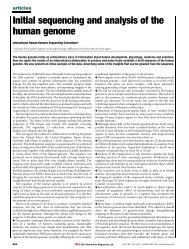Predictors of Foreign-Language Anxiety: Examining the ...
Predictors of Foreign-Language Anxiety: Examining the ...
Predictors of Foreign-Language Anxiety: Examining the ...
Create successful ePaper yourself
Turn your PDF publications into a flip-book with our unique Google optimized e-Paper software.
The remaining two learner variables, FL aptitude and strength <strong>of</strong> motivation,were not significantly related to FLA. As Table 1 shows, a weak inverse relationshipwas revealed between first-year English major participants’ anxiety scoresand <strong>the</strong>ir FL aptitude as measured by performance on <strong>the</strong> Hungarian <strong>Language</strong>Aptitude Test (r = -.143, p = .141). Low negative correlation coefficients were obtainedfor all four subtests <strong>of</strong> <strong>the</strong> HUNLAT, however <strong>the</strong>y did not reach a significantlevel. This finding suggests that participants’ FL aptitude was not closelyrelated to how much anxiety <strong>the</strong>y experienced in <strong>the</strong>ir university English classesand in o<strong>the</strong>r L2 situations. With regard to <strong>the</strong> potential link between FLA and motivation,<strong>the</strong> results are very similar to those for FL aptitude in that Pearson correlationsrevealed a very weak association between participants’ anxiety scores and<strong>the</strong> strength <strong>of</strong> <strong>the</strong>ir motivation for learning English, as measured by <strong>the</strong> selfreportquestionnaire (r composite = .085, p = .394), suggesting no significant relationshipbetween <strong>the</strong> examined motivational characteristics and level <strong>of</strong> FLA.Multiple regression findingsThis section presents <strong>the</strong> results <strong>of</strong> multiple regression analysis examining <strong>the</strong> simultaneouseffect <strong>of</strong> pr<strong>of</strong>iciency level, FL aptitude, strength <strong>of</strong> motivation, L2-selfconcept,competitiveness, and perfectionism on FLA. The aim <strong>of</strong> this procedurewas to determine <strong>the</strong> relative contribution <strong>of</strong> <strong>the</strong>se variables to first year Englishmajor participants’ anxiety level. Table 2 shows <strong>the</strong> initial model, with all sixlearner variables entered in <strong>the</strong> regression equation, while Table 3 presents <strong>the</strong> onesuggested as a better model by <strong>the</strong> backward selection method.Table 2: Initial multiple regression model for predicting FLAVariableStandardized regressioncoefficient (β)t value Squared partial correlationcoefficients (%)Pr<strong>of</strong>iciency -.090 -1.088 (n.s.) 1.27FL aptitude .062 .976 (n.s.) 1.02Strength <strong>of</strong> Motivation -.051 -.742 (n.s.) 0.59L2-self-concept -.676 -8.179** 42.12Competitiveness .278 4.220** 16.24Perfectionism .015 .222 (n.s.) 0.05Model R = .800; R 2 = .640; Adjusted R 2 = .617; Std. Error = 12.52; F = 27.304, p = < .0005** p < .0005The high R value (0.8) for <strong>the</strong> initial model indicates a strong linear relationshipbetween <strong>the</strong> six learner variables and FLA. As shown in Table 2, R 2 was 0.640,which means pr<strong>of</strong>iciency level, FL aptitude, strength <strong>of</strong> motivation, L2-selfconcept,competitiveness and perfectionism combined to explain 64% <strong>of</strong> <strong>the</strong> variancein first year English majors’ anxiety. According to Cohen’s (1988) criteria forassessing <strong>the</strong> predictive power <strong>of</strong> a set <strong>of</strong> independent variables, this indicates aTóth, Zs. <strong>Predictors</strong> <strong>of</strong> foreign-language anxiety 135
















